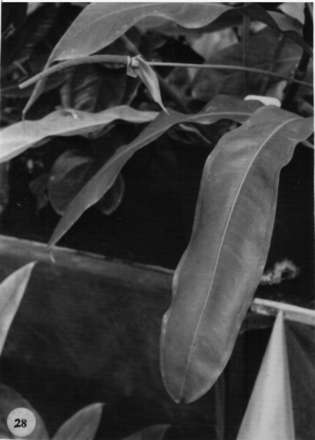




Anthurium burgeri Croat & Baker,
Brenesia 16 (Supl. I): 30. 1979. TYPE: Costa Rica. San José: ridges and steep slopes above Alfom-bra along road from San Isidro del General to Dominical (on Pacific coast) (9°18'N, 83°46'W), ca. 1,000 m, 19 November 1975, Burger & Baker 10096 (F 1769194, holotype; CR, K, MO, US, isotypes; Live at MO).
Epiphyte or terrestrial on steep banks; stem short or long, 1-1.3 cm diam.; roots few, directed downward; cataphylls moderately thin, 6-14 cm long, blunt to acuminate at apex, drying brown (B & K Red-yellow 4/10), remaining intact, subsequently deciduous.
LEAVES usually held ± erect to spreading; petioles 15-20
cm long, 4-6 mm diam. midway, terete; geniculum (0.5)1.5-2 cm long, weakly
flattened adaxially; blades ob-long-oblanceolate, moderately thick (drying
somewhat reddish-brown or gray with purplish splotches), gradually
acuminate at apex, narrowly cuncatc at base, 36-48 cm long, 6.8-8 cm wide,
broadest at orjust above the middle; upper surface glossy to semiglossy
or matte, lower surface semiglossy; midrib prominently raised above and
below, broad at the base, becoming acute and narrow, then diminished and
sunken at apex above, obtusely angled, sometimes tinged reddish near the
base below; primary lateral veins 10-20 per side, departing midrib at ca.
60° angle, ± straight to the collective vein, flat and somewhat
obscure above, raised below; collective vein arising from near the base,
more conspicuous than the primary lateral veins, 2-9 mm from margin, weakly
sunken above, prominulous below.
INFLORESCENCE spreading, as long as or longer than the leaves; peduncle 40-53 cm long, to 4 mm diam., terete, longer than petioles; spathe moderately thin, light green sometimes tinged purple at margins (B & K Yellow-green 7/10) oblong-lanceolate to lanceolate, 6.5-9 cm long, 1.3-2.3 cm diam., broadest near the base, acuminate-cuspidate at apex, rounded to weakly cordate and slightly clasping at base, the margins sometimes joining petiole at slightly different levels; spadix sessile, greenish-brown to purplish-brown (B & K Yellow 6/7.5), 9-12.2 cm long, 5-7 mm diam. at base, to 3 mm diam. at apex; flowers rhombic to weakly 4-lobed, 2-3 mm wide in both directions, the sides straight to weakly sigmoid; 5-9 flowers visible in either spiral; lepals weakly glossy to matte, pale yellow-green with purplish inner edges, pale punctate, with a few scattered droplets, lateral tcpals 1-1.3 mm wide, the inner margin broadly convex to almost straight; pistils weakly emergent, greenish; stigma cllipsoid-circular, ca. 5 mm long, brushlikc and exscrted, dark violet-purple, with a conspicuous droplet appearing briefly, well before first anthers emerge, dry and dark when anthers emerge; stamens emerging promptly from near the middle of the spadix or from the base, held ca. 1 mm above the tepals at anthesis, the filament ca. 3 times longer than the anthers, soon retracting the anther to the level of the tepals; anthers yellow-brown, 0.4-0.5 mm long, 0.7-0.8 mm wide, not contiguous; thecae weakly divaricate, oblong-elliptic: pollen orange (B & K Yellow 8/2.5), drying tan to whitish, quickly disappearing.
INFRUCTESCENCE pendent-spreading; spadix ca. 12 cm long, ca. 1.9 cm
diam., bearing berries in the basal half only; berries narrowly ovate, 6-6.7
mm long, 3-3.4 mm wide, acute to narrowly rounded at apex, red-orange (B &
K Yellow-red 5/2.5); pericarp red-orange; mesocarp gelatinous, pale orange,
with numerous raphide cells; seeds 1 or 2, elliptic, pale yellow, sometimes
weakly flattened, 3.2-3.5 mm long, 2-2.1 mm wide, 1.2-2 mm thick, surrounded
by a sticky amber envelope. Fig. 28.
The species is known only from the type locality in Costa Rica in premontane
rain forest. Anthurium burgeri can be distinguished by its oblong-oblanceolate
leaf blades with obscure primary lateral veins, and more or less straight, weakly
depressed collective veins arising from near the base. The midrib on the lower
surface is sometimes tinged reddish and the cataphylls turn brown and remain
intact. The inflorescence is equal to or longer than the leaves and the spadix
is greenish to purplish-brown with dark violet-purple stigmas. It does not seem
to be closely related to any other species in Central America. The sectional
placement of A. burgeri is as yet uncertain but is probably best placed
in section Xialophyllium despite the fact that it may sometimes
have short stems.
 |
Map of Mesoamerican specimens with coordinates
Costa Rica Puntarenas: Fila Costeña, 950-1150 m, 08.49.18N 83.11.15W,
10 December 1993, Michael Grayum 10654 (CR, MO).
Costa Rica San José:, , Burger & Baker 10096 (CR, F, K, MO, US).